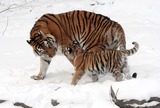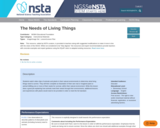
This video guides you on an activity to introduce your students to spiders and spiderwebs. This is for K-2 students.
- Subject:
- Science
- Material Type:
- Activity/Lab
- Provider:
- Reimagine Teaching
- Provider Set:
- Utah's Hogle Zoo
- Date Added:
- 11/30/2020

This video guides you on an activity to introduce your students to spiders and spiderwebs. This is for K-2 students.

This video guides you on an activity to get your students outside and excited about Life Science.

This video guides you on a Life Science activity. This video is for K-2 students.

This video guides you on an activity to get your students outside and excited about Life Science. This activity is good for Kindergarten through 2nd grade.

In this instructional video, the Hogle Zoo explains how to use the lesson plan "Habitat Design."

This article highlights hands-on or multimedia lesson plans about the tundra and ecosystem concepts. Science lessons are paired with suggested literacy lesson plans. All lessons are aligned to national standards.

Inspired by their curiosity about animals, students work together to research an animal of their choice and present the information they gather to an authentic audience.

This formative assessment item uncovers misconception and student ideas about classifications of mammals. It will uncover how students think when classifying animals. The probe is aligned to the National Science Education Standards. Information is provided for instructional suggestions and background information.

This article highlights lessons that help K-grade 5 students understand that animals and plants can only survive in certain environments.The lessons support the theme of an issue of the free online magazine Beyond Weather and the Water Cycle. The theme is "We Depend on Earth's Climate."

This article features children's literature about mammals and the mammals that live in the polar regions.

This lesson supports the 1st-grade science core strand 1.2: The Needs of Living Things and Their Offspring. Students obtain, evaluate, and communicate information about mother and baby animals and begin to construct an explanation of patterns in the behavior of parents and offspring which helps offspring to survive.

Students use critical literacy skills to understand the concept of perspective and to then create a diary for an animal they research with a partner.

In this 3-part unit, students will investigate the structures and functions of animals living in UtahÕs forests, deserts, and wetlands. Using this knowledge, they will create their own new species of animal that is adapted to one of these environments. This lesson is adaptable for in-class or at-home learning and aligned with SEEd standard 4.1.1.

How to use your Nature Inventions lesson plans for 2nd Graders.

How to use your Structure and Function lesson plans for 4th Graders.

How to use your Stability of Populations lesson plans for 6th Graders.

In this 3-part unit, students investigate structures and functions of rainforest animals. Using this knowledge, they will then design and create an invention inspired by nature. This lesson is adaptable for in-class or at-home learning and aligned with SEEd standard 2.2.4.

Students take a walk on the wild side when they research an animal and create a scavenger hunt activity for their classmates.

Students watch video clips of animals and plants in their natural environments to determine what living things need to survive. They will then complete an illustration of their own real or imagined plant or animal fulfilling one or more of their needs for survival, within their natural environment. While this lesson does a good job explaining how animals meet their needs through their environments, additional lessons and experiences with plants would need to be provided in order to meet the full standard.

In this instructional video, the Hogle Zoo explains how to use the lesson plan "A Night In the Life of a Beaver 2.2.2."